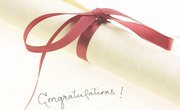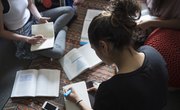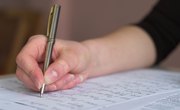If you study for hours but your test scores don't show it, take a look at how, when and where you're studying. Many different factors could be sabotaging your efforts. First, be sure you're paying attention in class. Ask the teacher what will be on the test. Attend all review sessions that are offered and listen for hints as to what will be on the test. Finally, look deeper into habits you can change that can make a big difference in your grades.
The Sweaty Palms Syndrome
Many students suffer "test anxiety" the day of the test. They can have real physical symptoms, including headaches, stomach aches, dizziness, sweaty palms and excess perspiration in general. Anxiety can be brought on or made worse by negative thoughts. Saying, "I'm just a bad test-taker" over and over makes the brain believe it. If you studied and know the material, tell yourself instead that you're prepared and will do well on the test. This boosts your confidence so you can do well. If anxiety is leading to panic before the test, calm down with slow, deep breaths. Exercise, like yoga and tai chi, have a calming effect that lasts and helps concentration, too.
Too Little, Too Late
Often, a student's idea of studying is cramming the night before the test. It isn't possible to learn several weeks' worth of material in one night. So while students who cram for tests think they're prepared, they really don't know the material as well as they should. Adding to that the fact that they probably didn't get enough sleep because they stayed up cramming, and they'll have poor concentration on the test. Instead, study a little every day. After each class, go over your notes. Repeat what you learned in your own words so you understand it. The day before the test, review your notes and go to bed early.
Get Serious
To make the most of your study time, show you mean it. Set aside a study spot with a desk and chair. Put away your cell phone, turn off the television and even your music. All are distractions that keep you from focusing. Talking also breaks your concentration, so let everyone know you're studying and shouldn't be disturbed. Take regular five-minute breaks, but don't watch TV or make phone calls, as you're likely to spend more than five minutes on them. If you need to, give yourself rewards such as a short phone call after studying for one subject.
Same Old, Same Old
If you always study in the same place and in the same way, shake things up a little. Connect a memory to smells by sitting on freshly cut grass while reading your notes. Large motor movements make connections in a different part of the brain, so dance around while reciting some important facts over and over. Read and record facts or terms you're having difficulty remembering, and play the recording while you're doing other things. Create visual images for each term you need to memorize. When you see the word, the image will pop up in your mind and the definition with it. Come up with creative phrases to remember facts, such as the way many people remember the colors of the rainbow with "Roy G. Biv."
Related Articles
References
Writer Bio
Barbara Bean-Mellinger is an award-winning writer in the Washington, DC area. She writes nationally for newspapers, magazines and websites on topics including careers, education, women, marketing, advertising and more. She holds a Bachelor of Science from the University of Pittsburgh.











